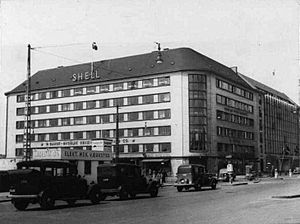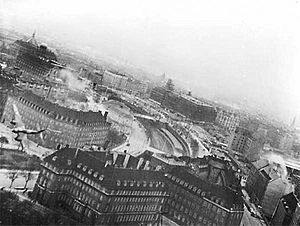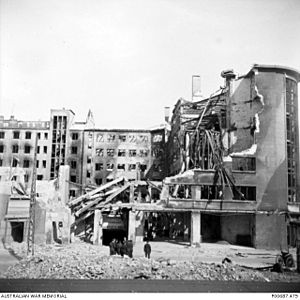Operation Carthage facts for kids
Quick facts for kids Operation Carthage |
|||||||
|---|---|---|---|---|---|---|---|
| Part of the Second World War | |||||||
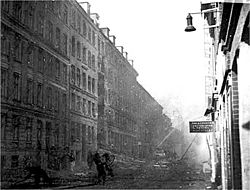 The air raid on the Shellhus |
|||||||
|
|||||||
| Belligerents | |||||||
| Strength | |||||||
| 20 bombers, 30 fighters | Various antiaircraft defences | ||||||
| Casualties and losses | |||||||
| 6 aircraft destroyed 9 aircrew killed 1 aircrew captured |
The Danish headquarters of the Gestapo destroyed 55 German soldiers and 47 Danish employees of the Gestapo killed |
||||||
| 125 Danish civilians killed, including 86 schoolchildren 8 Danish prisoners of the Gestapo killed |
|||||||
Operation Carthage, on 21 March 1945, was a British air raid on Copenhagen, Denmark during the Second World War which caused significant collateral damage. The target of the raid was the Shellhus, used as Gestapo headquarters in the city centre. It was used for the storage of dossiers and the torture of Danish citizens during interrogations. The Danish Resistance had long asked the British to conduct a raid against the site. The building was destroyed, 18 prisoners were freed and Nazi anti-resistance activities were disrupted. One online documentary includes footage taken by the RAF and interviews with those involved Part of the raid was mistakenly directed against a nearby school; the raid caused 125 civilian deaths (including 86 schoolchildren and 18 adults at the school). A similar raid against the Gestapo headquarters in Aarhus, on 31 October 1944, had succeeded.
Background
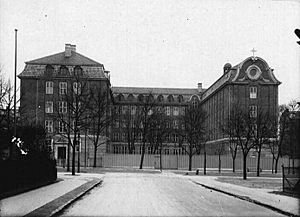
The raid was requested by members of the Danish resistance movement to free imprisoned members and to destroy the records of the Gestapo, to disrupt their operations. The RAF initially turned down the request as too risky, due to the location in a crowded city centre and the need for low-level bombing but they approved the raid in early 1945 after repeated requests. Once approval had been given, planning for the raid took several weeks; scale models of the target building and the surrounding city were built for use by pilots and navigators in preparation for a very low-level attack.
Raid
The attacking force consisted of Royal Air Force de Havilland Mosquito F.B.VI fighter-bombers of No. 140 Wing RAF, comprising No. 21 Squadron RAF, No. 464 Squadron RAAF, and No. 487 Squadron RNZAF. The aircraft flew in three waves of six aircraft, with two reconnaissance Mosquito B.IVs from the Royal Air Force Film Production Unit to record the results of the attack. There is a short film taken by the RAF, which is used in other online documentaries and the cited version is from a danish newspaper today Thirty RAF Mustang fighters gave air cover from German aircraft and these also attacked anti-aircraft guns during the raid.
The force left RAF Fersfield in the morning and it reached Copenhagen after 11:00. The raid was carried out at rooftop level and during the first attack, a Mosquito hit a lamp post, damaging its wing and the aircraft crashed into the Jeanne d'Arc School, about 1.5 km (0.93 mi) from the target, setting it on fire. Several bombers in the second and third wave attacked the school, mistaking it for their target.
Results
On the following day, a reconnaissance plane surveyed the target to assess the results. The damage was severe, with the west wing of the six-storey building reduced nearly to ground level. The Danish underground supplied a photograph showing the building burning from end to end.
The raid had destroyed the Gestapo headquarters and records, severely disrupting Gestapo operations in Denmark, as well as allowing the escape of 18 prisoners. Fifty-five German soldiers, 47 Danish employees of the Gestapo and eight prisoners died in the headquarters building. Four Mosquito bombers and two Mustang fighters were lost and nine airmen died on the Allied side.
On 14 July 1945, remains of an unidentified male casualty were recovered from the ruins of the Shellhus and transferred to the Department of Forensic Medicine of the University of Copenhagen. This happened again four days later and the two casualties were buried in Bispebjerg Cemetery on 4 and 21 September, respectively.
The Jeanne d'Arc School Casualties
The operation has nevertheless tragic consequences. One of the Mosquito in the first of three waves hit a tall lamppost, causing it to crash into a garage close to the school, roughly 1.6 km (1 mi) to the west-southwest of the Shellhuset. Two of the Mosquitos in the second wave mistook the burning structure as having been successfully bombed by the first wave, and dropped their bombs on the Jeanne d'Arc School killing 86 children and 18 adults (10 nuns, 2 firemen, 4 civil teachers and 2 fathers that tried to save their children) as well as wounding 67 children and 35 adults.
After the incident, the school never reopened. Most of the surviving children were transferred to another school, Institut Sankt Joseph. A monument in place of the school was inaugurated on March 23rd 1953 to remember the children and adult civilians that died on the day.
The pilots involved in the operation were only told after victory in Europe the true consequences of the raid.
A movie The Shadow in my Eye (also knows as The Bombardment as Netflix) was released in 2021 telling the stories of those children.
See also
- Aarhus Air Raid, a similar attack on Gestapo headquarters in Aarhus, Denmark
- Operation Jericho, a similar attack on Amiens Prison in France
- Oslo Mosquito raid, a similar attack on Gestapo headquarters in Oslo, Norway


